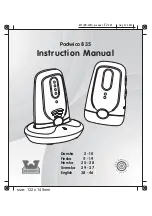
7-11
Rev 2.2, 10/31/94
7.5.3 Gain Setting
There are three places to adjust the gain of the 601: at the analog inputs, before the DSP
section, and after the DSP section. An understanding of this topic is essential to getting the
most from your 601. A more basic discussion can be found under the heading, "Gain Setting,"
in Chapter 2.
First, the analog input gains. You make best use of the 601’s signal-to-noise ratio by ensuring
that your analog input signals are adjusted to just (barely) fit within the input range of the A/D
converter. Doing so ensures that the entire conversion range of the converter gets used,
ensuring maximum dynamic range through the digital portions of the unit. Set the
L
INE
or
M
IC
gain controls so that the 6 dB input headroom LED illuminates on signal peaks. The red
C
LIP
LED should never illuminate.
Next, the input digital gain (
gAIn
in the global parameter group). Most of the time, set the digital
input gain to 0 dB. If you are heavily equalizing at 2 or more overlapping frequencies on the
equalizer, you may also need to reduce the digital signal level slightly to accommodate the extra
boost. If you have a weak analog input signal, and the analog input gain is already wide open,
then it is OK to add some digital input gain to bring the overall signal level up. Note that doing
so will cost you some noise performance.
Finally, the output digital gain (
L
EVEL
/P
AN
switch). Set this parameter so that the 2 dB output
headroom LED illuminates on signal peaks. The red
C
LIP
LED should never illuminate.
Neither
C
LIP
LED monitors the signal levels within the DSP blocks; you must use your ears If
you fear clipping within the DSP blocks, you can always reduce the input digital gain (
gAIn
)
slightly.
7.5.4 Equalization
The 601’s parametric equalizer has three overlapping bands. Each band can operate as a
peaking or notching equalizer, and bands 1 and 3 may be converted to lowpass and highpass
shelving curves. Each band operates over a range of 31 to 21.11 kHz with a bandwidth range of
.05 octave to 3 octaves. The boost and cut range for each band is +18, -50 dB.
Since each band covers the same frequency range, it is possible to apply equalization at the
same frequency in three places. Doing so could conceivably increase the signal level by 54 dB
at one frequency. You may need to reduce the input digital gain to avoid distortion.
A parametric equalizer offers perhaps the greatest
flexibility of any type of equalizer, however it can be more
difficult to arrive at a setting than with other equalizers. A
good strategy for setting any equalizer is to set the level
control for maximum boost, then vary the
F
REQUENCY
and
B
ANDWIDTH
until you locate the
portion of the spectrum that you wish to modify. Then refine the setting of the
L
EVEL
control for
that band. Next refine the setting of the
B
ANDWIDTH
control. You may have to go back and forth
1
The source for these numbers is actual performance graphs published in the following
article:
EQ Empirically
, Keith Andrews, Studio Sound magazine, December 1991. The API and
Focusrite equalizers were measured at Symetrix.
Name
BW (min)
BW (max)
API 550
1.6
n/a
Focusrite
0.6
1.8
Neve V3
0.2
3.0
SSL G
1.4
2.8
SSL E
0.5
2.5
Figure 7-6. Bandwidth Specs for some
popular equalizers.
Electronic considerations aside, one of the contributing
factors to an equalizer's sound is its bandwidth. Figure
7-6 lists the bandwidths (octaves) for several (possibly)
familiar analog equalizers, as found on their respective
mixing consoles. While we make no promise that the
601 will sound identically, these settings may be a good
starting point if one of these equalizers is within your
frame of reference.
1
Summary of Contents for 601
Page 46: ...4 18 Rev 2 2 10 31 94 This page is blank believe it or not ...
Page 48: ...4 20 Rev 2 2 10 31 94 Notes ...
Page 50: ...5 2 Rev 2 2 10 31 94 Notes ...
Page 70: ...7 16 Rev 2 2 10 31 94 Notes ...
Page 72: ...8 2 Rev 2 2 10 31 94 Notes ...
Page 74: ...9 2 Rev 2 2 10 31 94 Notes ...
Page 78: ...11 2 Rev 2 2 10 31 94 Notes ...
Page 126: ...D 12 Rev 2 2 10 31 94 Notes ...
Page 138: ...G 8 Rev 2 2 10 31 94 Notes ...
















































